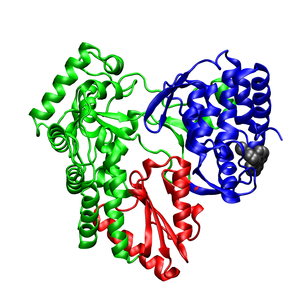 |
|
Contact Information
Office: MEYR 247B
Phone: 410-455-5728
Email: ithorpe@umbc.edu
Lab Website
|
Assistant Professor
Professional Interests
Molecular Simulation and Biophysical Modeling
My core interests are to understand the fundamental physical principles that govern the interplay between protein structure, function and dynamics. My objective is to study biological questions that have a tangible, positive impact on societal problems. Primary tools in this undertaking are theoretical and molecular simulation methods. I embrace a multidisciplinary approach to research and value collaborations with experimental groups.
Allosteric Inhibition of Hepatitis C Viral Polymerase
Hepatitis C virus (HCV) affects about 170 million people worldwide and is an important public health concern. I intend to identify novel therapeutic strategies to counter HCV infection by examining, at the molecular level, the physical properties that govern inhibition of the viral RNA-dependent RNA polymerase (gene product NS5B) which replicates the HCV genome. Several classes of allosteric inhibitors bind to the enzyme away from the site of nucleotide addition to a nascent RNA strand. The mechanism of action of these inhibitors is not well understood, and to date there have not been systematic studies to understand the molecular origin of inhibition. I will employ molecular simulation methods to obtain a detailed physical description of the structural and dynamic properties of NS5B in order to determine the source of allosteric inhibition. My goals are to:
i) identify the molecular origin of allosteric inhibition
ii) locate novel allosteric binding sites on the enzyme surface
iii) identify new small molecule inhibitors that can bind to known or newly identified allosteric sites.
Engineering Algal Enzymes for Biofuel Production
A worldwide effort to find renewable alternatives to fossil fuels is underway. Under certain conditions, algae produce substances that can be be used as biofuels such as hydrogen, hydrocarbons and lipids. We are particularly interested in lipid production as lipids can be readily converted to biodiesel and thus could be easily substituted for fossil fuels. However, the lipid biosynthetic pathway of algae is not fully understood. This project seeks to understand the metabolic pathways involved in lipid biosynthesis in algal species. We seek to identify ways to modify the properties of enzymes involved in lipid biosynthesis to increase overall lipid production. We combine structural information available for these enzymes with kinetic modeling, molecular simulation, phylogenetic analysis and biochemical data to identify rational design strategies to enhance lipid production.
Selected Publications
- Iwona E. Weidlich, Igor V. Filippov, Jodian Brown, Neerja Kaushik-Basu, Ramalingam Krishnan,Marc C. Nicklaus and Ian F. Thorpe. ‘Inhibitors for the hepatitis C virus RNA polymerase explored by SAR with advanced machine learning methods’ Bioorg. Med. Chem.; 2013, 21, 3127-3137.
- Davis, B. C. and Thorpe, I. F. ‘Thumb inhibitor binding eliminates functionally important dynamics in the hepatitis C virus RNA polymerase’Proteins: Struct., Funct., Bioinf.; 2013, 81, 40-52
- Bagchi, S., Thorpe, D. G., Thorpe, I. F., Voth, G. A. and Fayer, M. D. “Conformational Switching between Protein Substates Studied with 2D IR Vibrational Echo Spectroscopy and Molecular Dynamics Simulations” J. Phys. Chem. B; 2010, 114, 17187-17193
- Zimmermann, J., Romesberg, F. E., Brooks C. L. III and Thorpe, I. F. “A molecular description of flexibility in an antibody combining site” J. Phys. Chem. B; 2010, 114, 7359-70
- Thorpe, I. F., Zhou, J. and Voth, G. A. “Peptide folding using multiscale coarse-grained models” J. Phys. Chem. B, 2008, 112, 13079-13090
- Maupin, C. M., Saunders, M. G., Thorpe, I. F., McKenna, R., Silverman, D. N. and Voth G. A. “Origins of enhanced proton transport in the Y7F mutant of human carbonic anhydrase III” J. of the Am. Chem. Soc., 2008, 130, 11399-11408
- Zhou, J., Thorpe, I. F., Izvekov, S., and Voth, G. A. “Coarse-grained peptide modeling using a systematic multiscale approach” Biophys. J., 2007, 92; 4289-4303
- Thorpe, I. F. and Brooks, C. L. III. “Molecular evolution of affinity and flexibility in the immune system” Proc. Natl. Acad. Sci. USA, 2007, 104, 8821-8826
- Zimmermann, J., Oakman, E. L., Thorpe, I. F., Shi, X., Abbyad, P., Brooks, C. L. III., Boxer, S. G. and Romesberg, F. E. “Antibody evolution constrains conformational heterogeneity by tailoring protein dynamics” Proc. Natl. Acad. Sci. USA, 2006, 103, 13722-13727
- Ohkubo, Y. Z. and Thorpe, I. F. “Evaluating the conformational entropy of macromolecules using an energy decomposition approach” J. Chem. Phys.,2006, 124, 024910
- Thorpe, I. F. and Brooks, C. L. III. “Conformational substates modulate hydride transfer in dihydrofolate reductase” J. of the Am. Chem. Soc., 2005, 127, 12997-13006
- Thorpe, I. F. and Brooks, C. L. III. “The coupling of structural fluctuations to hydride transfer in dihydrofolate reductase” Proteins: Struct., Funct. Bioinf.,2004, 57; 444-457
- Thorpe, I. F. and Brooks, C. L. III. “Barriers to hydride transfer in wild type and mutant dihydrofolate reductase from E. coli” J. Phys. Chem. B, 2003, 107; 14042-14051
Honors and Awards
Courses Taught
- CHEM 302: Physical Chemistry II
- CHEM 444: Molecular Modelling
- CHEM 437: Comprehensive Biochemistry I
- CHEM 644: Molecular Modeling
Survey of computational methods for the molecular simulation of biopolymers. Introduction to molecular dynamics and monte carlo simulations. Covers concepts such as energy landscapes, force fields, electrostatic interactions, influence of solvents, assessing the convergence of molecular simulations and analysis of simulation data. Applications primarily to proteins, though nucleic acids, sugars and lipids will also be mentioned. Calculations using the CHARMm and/or GROMACS simulation codes. - CHEM 690: Chemistry Seminar
- CHEM 710: Research Tutorial in Chemistry
- CHEM 713: Biochemistry/Chemistry Seminar
